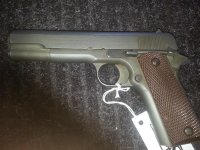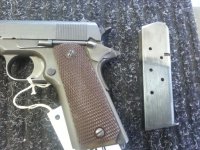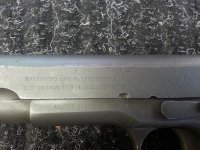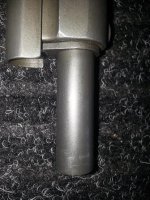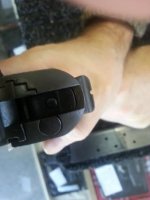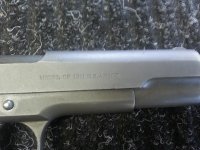I found this at a dealer. He is asking 1500. To me it looks like it has been reparkarized as I think these were blued yet at that serial number. I don't know about the inside numbers but if they are correct, what about the rest of this gun? Thanks for your responses.
You are using an out of date browser. It may not display this or other websites correctly.
You should upgrade or use an alternative browser.
You should upgrade or use an alternative browser.
Is this 1911 A1 worth a crap?
- Thread starter oldcolts
- Start date
That's a 1911, not a 1911 A1. Looks like it was originally manufactured between 1915 - 1918 or there about (could be 1914?). Then parkerized at a later date and possibly used in service during WWII. Yes, it would have originally been blued. Parts/numbers may or may not match. It might not have it's original barrel - could have been replaced when it was parkerized. You'd have to pull it apart to find out.
Is it a piece of crap? No, but it's collector's value would be limited. Personally, I'm looking to purchase an all original 1911 manufactured in 1912 or 1913. I'd be willing to spend more than $1,500 if the condition was right. But, I wouldn't pay $1,500 for that gun. Mainly because it's not in my date range and the fact it was refurbished at some time just makes it something I don't want.
Rough guess without knowing anything else about the gun is it should sell for less than $1,000. Also, those aren't the original grips.
Is it a piece of crap? No, but it's collector's value would be limited. Personally, I'm looking to purchase an all original 1911 manufactured in 1912 or 1913. I'd be willing to spend more than $1,500 if the condition was right. But, I wouldn't pay $1,500 for that gun. Mainly because it's not in my date range and the fact it was refurbished at some time just makes it something I don't want.
Rough guess without knowing anything else about the gun is it should sell for less than $1,000. Also, those aren't the original grips.
Aguila Blanca
Staff
The lettering on the slide has serifs -- the lettering on the frame is block lettering. I know there was a period when the two were mixed, but I was under the impression it was mixed from one side of the slide to the other, not slide to frame.
The pistol is badly pitted under that parkerizing. I don't think ANY M1911s were parkerized -- that came later, after the M1911A1 had been adopted.
There's not much in the way of collector value in that thing, IMHO. It's certainly not a $1500 pistol ... more like $500, and for just a bit over $500 you can buy a new 1911 with a lifetime warranty.
The pistol is badly pitted under that parkerizing. I don't think ANY M1911s were parkerized -- that came later, after the M1911A1 had been adopted.
There's not much in the way of collector value in that thing, IMHO. It's certainly not a $1500 pistol ... more like $500, and for just a bit over $500 you can buy a new 1911 with a lifetime warranty.
This is a web site to semi-educate one's self prior to looking at either an M1911 or a M1911A1: http://coolgunsite.com/
Last edited:
The frame is from 1918, but the slide is earlier than that; the rampant colt marking was moved from the rear of the slide to the middle, at about serial number 275,000.
A lot of "abouts" when making determinations about WWI-era Colts, as they were averaging 1000 pistols a day during 1918.
M1911s were parkerized during post-WWI rebuilds, and should have stamps - AA, in this case? - applied by the arsenal doing the work.
A lot of guns missed the rebuild effort, too. I have a 1918 Colt that my dad bought straight from Uncle Sam, shipped from a U.S. arsenal in the '50s, and it's still blued, and came with only a couple of later, M1911A1 small parts.
A lot of "abouts" when making determinations about WWI-era Colts, as they were averaging 1000 pistols a day during 1918.
M1911s were parkerized during post-WWI rebuilds, and should have stamps - AA, in this case? - applied by the arsenal doing the work.
A lot of guns missed the rebuild effort, too. I have a 1918 Colt that my dad bought straight from Uncle Sam, shipped from a U.S. arsenal in the '50s, and it's still blued, and came with only a couple of later, M1911A1 small parts.
In the WWII era, AA stood for Augusta Arsenal, Georgia.
At this point it probably is not possible to determine if the Parkerizing was done by an Army arsenal (Augusta) or by someone after it left service. But the gun at some point was apparently a mass of rust and pitting, and it was refurbished and made into a serviceable, if not very attractive, pistol.
Remember that in the early days of WWII, the mission was to get guns into the hands of the troops; they didn't need to be pretty, just capable of killing people.
I don't see an "EE" marking; the only "EE" inspector would have been EEC (Maj. Edmund E. Chapman, who was at Remington Arms-UMC in WWI), and that is not a Remington frame.
So, an M1911 pistol, refurbished and reParkerized by persons unknown. Will it work? Very likely, and maybe more reliably than a lot of modern guns. Does it have collector value, as much as $1500? No.
Jim
At this point it probably is not possible to determine if the Parkerizing was done by an Army arsenal (Augusta) or by someone after it left service. But the gun at some point was apparently a mass of rust and pitting, and it was refurbished and made into a serviceable, if not very attractive, pistol.
Remember that in the early days of WWII, the mission was to get guns into the hands of the troops; they didn't need to be pretty, just capable of killing people.
I don't see an "EE" marking; the only "EE" inspector would have been EEC (Maj. Edmund E. Chapman, who was at Remington Arms-UMC in WWI), and that is not a Remington frame.
So, an M1911 pistol, refurbished and reParkerized by persons unknown. Will it work? Very likely, and maybe more reliably than a lot of modern guns. Does it have collector value, as much as $1500? No.
Jim
FWIW, there was no blanket "rebuild effort"; small arms were rebuilt/refinished as necessary, when they failed inspection or when there were shiny areas that could reflect light and give away a soldier's position. Otherwise, they were deemed serviceable and issued.
In the arms room c. 1957, I had an M1911 that was all original, with no sign of any replaced parts. It was probably in 90% condition. It also happened to be the most accurate of all the pistols in the unit.
Jim
In the arms room c. 1957, I had an M1911 that was all original, with no sign of any replaced parts. It was probably in 90% condition. It also happened to be the most accurate of all the pistols in the unit.
Jim
I agree with Aguila.
This gun may or may not have been in military service. If it was at some point someone took it home and allowed it to begin to rust and develop bad pitting. At that point someone decided to clean it up some, refinish it and try to sell it.
The gun had more value with it's original finish and rust on it than it does refinished. That is not a GI refinish. The military did not do that.
So it's value is as an old shooter. Maybe $500. tops, likely less. I would not pay $500. for it.
tipoc
This gun may or may not have been in military service. If it was at some point someone took it home and allowed it to begin to rust and develop bad pitting. At that point someone decided to clean it up some, refinish it and try to sell it.
The gun had more value with it's original finish and rust on it than it does refinished. That is not a GI refinish. The military did not do that.
So it's value is as an old shooter. Maybe $500. tops, likely less. I would not pay $500. for it.
tipoc
Hi, Tipoc,
The gun was certainly in military service at one time, since it is a military contract gun. And it could very well have been rusted and pitted in service, especially if it had been in the trenches in WWI.
As to "That is not a GI refinish. The military did not do that", I wonder how you reached that conclusion, since I see nothing that precludes it having been Parkerized at an Army depot, and the type and color of the Parkerizing is consistent with the WWII era.
Jim
The gun was certainly in military service at one time, since it is a military contract gun. And it could very well have been rusted and pitted in service, especially if it had been in the trenches in WWI.
As to "That is not a GI refinish. The military did not do that", I wonder how you reached that conclusion, since I see nothing that precludes it having been Parkerized at an Army depot, and the type and color of the Parkerizing is consistent with the WWII era.
Jim
The gun was certainly in military service at one time, since it is a military contract gun. And it could very well have been rusted and pitted in service, especially if it had been in the trenches in WWI.
I was not clear. The gun was a GI gun. However there is no reason to believe that it saw combat or was deployed in a combat area without further information. A 1918 gun.
The amount of pitting on the slide is extensive. It also means that the rust itslef was more extensive than the pitting which occurs where the rust is it's worst and has time to eat in extensively. This does not happen overnight. It looks like the type that comes from a gun sitting for months (or longer depending on climate) in a damp holster.
It would have been extremely unusual for any GI or officer to allow their sidearm to rust so extensively. It would have been at least regularly wiped down and removed from a holster particularly in damp or wet environs. That amount of rust does not come from hard use. It comes from neglect.
It could be possible that while in service to be allowed to rust so extensively but it's kinda unlikely.
An arsenal rebuild could have mixed the frame and original slide.
Look closely at the frame and slide. You can see that there was extensive polishing of the slide to remove the rust. So much that many of the roll marks are hard to read. This was done prior to the park job.
The military usually did not parkerize such extensively damaged slides. They did not have to take the time. They had spare slides. So unlikely the military did the polish and park.
So to me two unlikely things.
That's why I think it's more likely that the gun was a bring back. A gun out of service in private hands that was left to rust and then polished and parked while in the hands of a private owner.
The rust hurt it's collector value but what really hurt was the the polish and park. My opinion for what it's worth.
tipoc
Last edited:
We agree that the rust damage was extensive and the pitting was deep.
But no one has any idea where that gun had been, and contrary to your assumption, soldiers in combat under adverse conditions did NOT always keep their weapons pristine. The gun could even have been lost in the mud and dirt of a battlefield and found months later. I have seen other weapons that were rebuilt/refurbished by the Army that showed pitting and rust as bad as that under the fresh Parkerizing. Unless the pitting was so deep as to compromise the strength of the material, it would be wirebrushed or polished/ground off.
Also contrary to your assumption, NO weapons were kept intact through the rebuild process. Arsenal rebuild instructions for the 1911 essentially say "throw frames in pile A, throw slides in pile B". All parts were required to be interchangeable for a reason. Parts were checked and those determined to be serviceable were refinished as necessary and used to assemble guns. No attention whatsoever was paid to manufacturer, serial number, or era of the original manufacture, and no special effort was made to preserve factory markings. I mentioned above that I had an M1911 in the arms room that was totally original. But I also had some with M1911A1 slides on M1911 frames and vice versa.
Collectors tend to value "matched" guns in perfect condition. But to the Army, they were all simply weapons, made for shooting the enemy; matching parts made no difference at all.
As I said, no one can be sure where or when the refinishing was done, but I will say again that I see nothing to indicate that it was NOT done in an Army arsenal or depot.
Jim
But no one has any idea where that gun had been, and contrary to your assumption, soldiers in combat under adverse conditions did NOT always keep their weapons pristine. The gun could even have been lost in the mud and dirt of a battlefield and found months later. I have seen other weapons that were rebuilt/refurbished by the Army that showed pitting and rust as bad as that under the fresh Parkerizing. Unless the pitting was so deep as to compromise the strength of the material, it would be wirebrushed or polished/ground off.
Also contrary to your assumption, NO weapons were kept intact through the rebuild process. Arsenal rebuild instructions for the 1911 essentially say "throw frames in pile A, throw slides in pile B". All parts were required to be interchangeable for a reason. Parts were checked and those determined to be serviceable were refinished as necessary and used to assemble guns. No attention whatsoever was paid to manufacturer, serial number, or era of the original manufacture, and no special effort was made to preserve factory markings. I mentioned above that I had an M1911 in the arms room that was totally original. But I also had some with M1911A1 slides on M1911 frames and vice versa.
Collectors tend to value "matched" guns in perfect condition. But to the Army, they were all simply weapons, made for shooting the enemy; matching parts made no difference at all.
As I said, no one can be sure where or when the refinishing was done, but I will say again that I see nothing to indicate that it was NOT done in an Army arsenal or depot.
Jim

